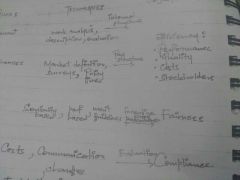![]()
![]()
![]()
Use LEFT and RIGHT arrow keys to navigate between flashcards;
Use UP and DOWN arrow keys to flip the card;
H to show hint;
A reads text to speech;
39 Cards in this Set
- Front
- Back
- 3rd side (hint)
|
4 contrasting perspective of compensation |
1) Society 2) Stakeholders 3) Managers 4) Employees |
SSME |
|
|
Society Perspective |
1) Pay as Measure of justice 2) Benefits as reflection of justice in society 3) Belief that as pay increases Price Increases. 4) Job losses/gains- differences in compensation |
|
|
|
Stakeholders |
1) Stock as method of payment creates sense of ownership 2) linking executive pay with company's performance, supposedly increases stock prices. |
(Shareholders+ creditors ) |
|
|
Managers |
1) Expense : should be controlled 2) as a tool for motivation |
|
|
|
Employees |
1) financial security 2) return in exchange of services provided 3) Entitlement for being part of the company 4) Reward for the job well done |
|
|
|
Define Compensation |
Refers to all form of Financial returns Tangible services Benefits Employees receive as part of employment relationship |
|
|
|
Total return |
Total compensation + Relational returns |
|
|
|
Total compensation |
Cash components Benefits components |
|
|
|
Relational returns |
Recognition and status Employment security Challenging work Learning opportunities |
4 components |
|
|
3 components of Benefits Return |
1) income protection 2) allowance 3) work life balance |
|
|
|
4 components of Cash Compensation |
1) Basic Pay 2) merit (good work, performance of the past) 2.1) COLA/DA 3) Short term incentives 4) Long term incentives |
|
|
|
Long term incentives |
ESOP = Employee Stock option plans Employee Stock ownership plan , that is (pension plan) |
|
|
|
COLA/DA |
Directly proportional to Consumer Price Index |
|
|
|
Components of pay model |
1) Compensations objectives 2) Policies that make up the foundation of Compensation System 3) Techniques that make up the compensation system. |
|
|
|
Purpose of Compensation objectives |
1) they guide the design of the past system 2) they serve as the standards to judge the success of pay system |
|
|
|
Compensations objectives |
1) improve employees performance 2) fairness of the pay system 3) procedural fairness 4) Compliance to law 5) ethics 6) retention |
|
|
|
Compensations policy |
1) internal alignment 2) external competitiveness 3) employees contribution 4) management and administration of payment system |
|
|
|
Reward effort ratio |
>1 then good compensation |
|
|

|

|
|
|
|
Pay structure components |
1) Salary 2) Allowances and reimbursement 3) Social amenities and benefits 4) Retirement benefits 5) Performance related pay |
|
|
|
Basic Pay |
Is the part of the compensation that an employer gives for the work performed. It tends to reflect the value of work or skills. |
|
|
|
Increment |
Periodic upward adjustment of basic pay |
|
|
|
Basic pay = |
Pay in the pay band + grade pay |
|
|
|
D.A |
To prevent the erosion of your basic pay. |
|
|
|
Specific rate of D.A |
Everyone in the organisation is paid same amount of D.A. |
|
|
|
Indexed rate of D.A. |
It follows some index price number. |
|
|
|
types of Indexed D.A |
1) Graded system 2) flat system |
|
|
|
Flat system |
Everyone is paid at the same rate. Hence, higher the salary, higher absolute amount of D.A. |
|
|
|
Graded system |
As the grade go up, the rate of D.A fall down or, the person with the lower grade will get the higher rate of D.A. |
|
|
|
Piece rated plan |
Number of units produced, per hour. |
|
|
|
Standard hour plan |
Total time needed to complete a job. |
|
|
|
Roman plan |
Similar to Halsey plan. In it employees and employer, split the savings arising out of work done, in less than standard time. Bonus rises as the time taken to finish the job decreases. |
|
|
|
Gantt plan |
Standard time is fixed at a high level. If you achieve that, you get a bonus. |
|
|
|
Gain sharing plan |
Based on cost sharing. Meaning if you're able to reduce the cost of production, you get bonus out of that amount. Not profit sharing. |
|
|
|
Scanlon plan |
Wage bill or payroll cost÷sales value of production. Aims. How much excess wage is there. |
|
|
|
Rucker plan |
Labour cost÷value added Aims. How much excess production has been done. |
|
|
|
Output worth = |
Productivity ratio × wages paid to the worker. |
|
|
|
Productivity ratio = |
1 ÷ {value added × value added from labour}. |
|
|
|
Improshare = |
Actual hours worked ÷ total standard work hours. |
|

